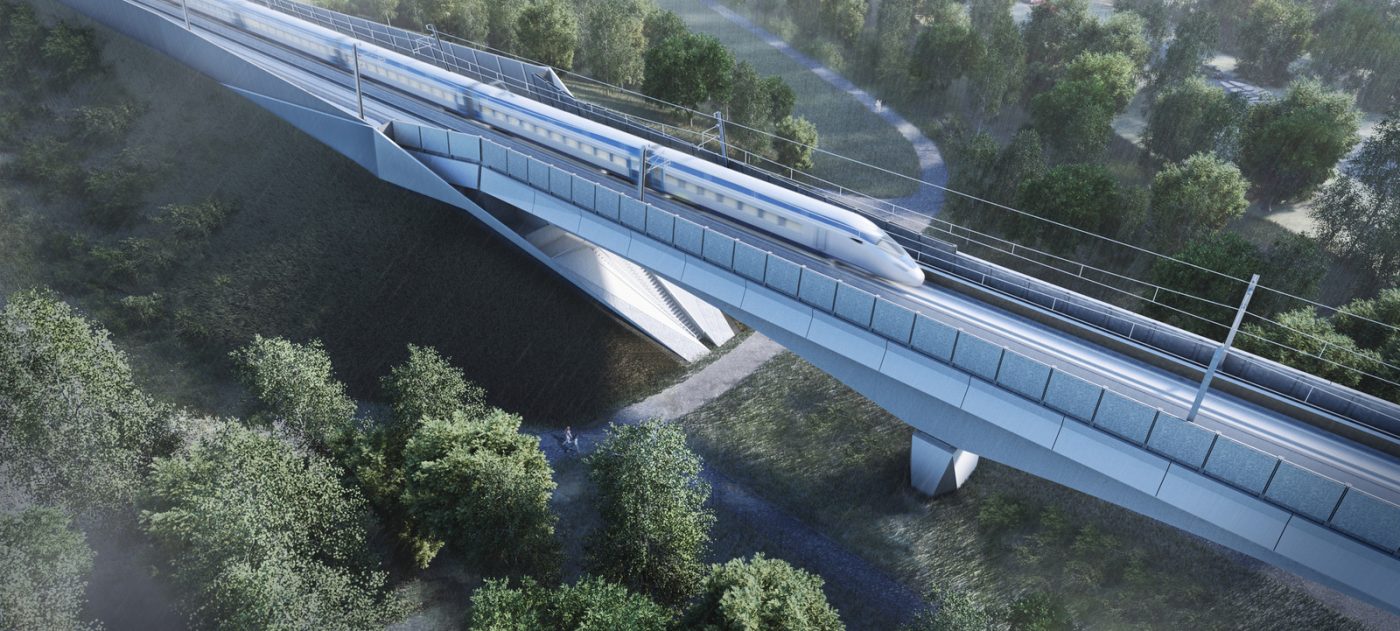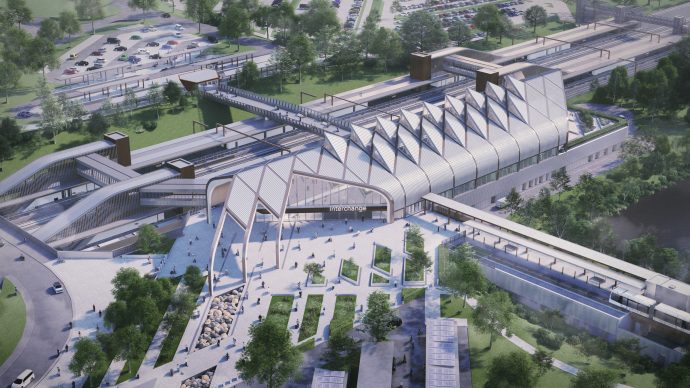
A climate resilient railway
HS2 is being designed to operate into the 22nd century, which includes making it resilient to our changing climate. As the new backbone for Britain’s transport network, it’s critical the railway can withstand extreme hot and cold weather, heavy rain, high winds and storms which are becoming more common.
Building infrastructure to function during changing climate
We are designing HS2 to withstand the impact of climate change and extreme weather by integrating climate change adaptation and resilience into each stage of the project. We have assessed the impact of climate change on HS2 in our Environmental Impact Assessments. We have also considered how climate change, in combination with the impacts of the railway, may affect communities, businesses and the natural, historic and built environment along the route.
Withstanding extreme weather
Flood risk and drainage systems
Flood risk is reduced through drainage systems that prevent flooding and water accumulation on the tracks, without increasing the risk of flooding elsewhere. This includes the use of our ‘green tunnels’, with cut-and-cover designs and plants on top that act as a natural drainage system, well-designed ditches, culverts, and other drainage structures, and slabs to support our tracks. Slabs drain water swiftly, prevent erosion, and ensure stability, reducing the risk of line disruptions. All this means that the HS2 rail line is designed to be resilient to a one in 1,000 year rain event.
Heat and cold resistance
Hot weather can cause overhead power lines to expand and sag, buckle the rails and even cause the ground beneath the railway to become unstable. This can lead to the closure of lines or force trains to operate at slower speeds, causing inevitable disruption for passengers.
Our tracks are designed with rail expansion devices to accommodate thermal expansion and contraction to prevent them from buckling and causing delays during heatwaves. Similarly, the rail expansion devices a long with specialised drainage systems ensure people will be able to keep moving even when cold temperatures and snow hit the UK.
Points – moveable sections of the line that allow trains to switch between tracks – can freeze in cold weather, bringing the railway to a halt. All of HS2’s points will be fitted with a heating system that is automatically activated when temperatures drop below a certain level. This makes sure they will keep working, even in icy weather, helping to maintain the punctual operation of the railway.
Ambient temperatures
The design for the new Old Oak Common Station features exposed surfaces that will absorb solar radiation entering through the roof-lights and other un-shaded areas to minimise the risk of indoor air temperature increases. We will also include ‘shading devices’ to minimise the risk of overheating in both indoor and outdoor spaces. We have also completed a climate change adaptation and resilience strategy for all our stations as part of our work on BREEAM (a measure of sustainability for new and refurbished buildings).
Wind
Overhead power lines can be brought down in strong wind, which causes major disruption to services. To mitigate this risk, HS2 will use an updated version of the overhead power lines developed for the for the Lyon – Marseille high speed line.
To further enhance resilience masts carrying overhead electric wires are placed closer together on sections exposed to stronger winds e.g. on viaducts. Sharing the load of carrying the wires between more masts reduces the weight carried by each one, thus enhancing the line’s resilience against strong wind. Distances between masts on HS2 will range between 45 metres and 72 metres to ensure operational resilience.
Landslips
Landslips can cause major disruption, with earth spilling onto the tracks from above or crumbling away beneath a line, causing the railway to be closed. This often happens on the existing railway after long periods of heavy rain, when the ground becomes saturated. HS2 is being built with significantly shallower cuttings and embankment slopes than seen on the existing Victorian-built railway to significantly improve stability. Furthermore, careful planting of vegetation, non-shrinkable soils (which avoid absorbing large quantities of water) and extensive in-built drainage will ensure stable ground around the railway.
Leaves
Thousands of tonnes of leaves fall onto railway lines in autumn each year from millions of lineside trees. They can be crushed by passing trains, creating a slippery layer on the rail similar to black ice on roads, making it harder for trains to accelerate or brake. HS2 will ensure that specific tree species will be avoided from day one to minimise the risks associated with leaf fall. Trees will also be planted well away from the line to avoid them being blown onto tracks during strong wind.
More information
These are just a few examples of how we are creating a future-proofed railway. More detailed information on how we are preparing for and adapting to the risks associated with climate change can be found in our Phase One and Phase 2a information papers, or the Phase One Code of Construction Practice and our Environmental Policy, our Environmental Sustainability Progress Report, and our Climate Adaptation Report.
Collaborating for climate resilience
Architects, engineers and environmental specialists are all working together to innovate across the HS2 project and deliver a resilient railway. We are also working with industry and in academic partnerships to gain a better understand of climate change adaptation more broadly.
Our collaborations
National Environmental Research Council
For example, we are part of a cutting-edge research programme led by the National Environmental Research Council. One of its aims is to translate existing research into tangible, industry-relevant tools and approaches that help infrastructure owners manage environmental risks.
Tomorrow’s Railway and Climate Change Adaptation
HS2 has also contributed to Tomorrow’s Railway and Climate Change Adaptation (TRaCCA) – a research project run by RSSB, the rail safety body. This has provided a range of decision-making tools and information which will enable railways to become more resilient. The tools include methods for financially evaluating climate adaptation investments; geospatially-based methods to integrate many of the metrics currently captured by the industry; and systems tools to provide insight into critical interfaces and dependencies, inside and outside of the railway system.
Infrastructure Operators Adaptation Forum
In addition, we are part of the Infrastructure Operators Adaptation Forum, which includes representatives from all other major infrastructure sectors, including Network Rail, National Grid and Severn Trent Water. Forum members learn from each other and work towards a vision for infrastructure assets and services that are resilient to today’s natural hazards and prepared for the future climate.
Institute of Environmental Management and Assessment
HS2 has collaborated with others to develop leading standards on climate change assessment and management. For example, working with the Institute of Environmental Management and Assessment (IEMA) on its recent guide on the effective consideration of climate change resilience and adaptation in the Environmental Impact Assessment process.
BSI
We have also collaborated with BSI, the UK national standards body, on the standard BS EN ISO 14090 Adaptation to Climate Change. Principles, Requirements and Guidelines. This standard offers a framework that enables organisations to give appropriate consideration to climate change adaptation when designing and implementing policies, strategies, plans and activities.
Our climate change adaptation and resilience report
Our latest Climate Adaptation and Resilience report highlights our progress so far, including showcasing our best practice in integrating climate change into planning, designing and construction of our railway, presents an assessment of our climate-related risks, demonstrates our effective integration of climate risk management into the organisation and identifies our ongoing work on climate adaptation and resilience.
The Climate Change Act 2008 established the Adaptation Reporting Power (ARP), which allows the Government to ask key organisations to report on the steps they are taking to prepare for climate change. Our latest report is our second ARP report under the fourth round of reporting, providing an update on our approach and risks from our initial report, produced in December 2021 (ARP3). We are the first stand-alone project in the design and construction phase to submit an ARP report. It shows our commitment to being an exemplar for the industry.

How we're managing construction impacts on the environment

Air quality
HS2 will cut emissions, improve air quality and support a net-zero carbon economy.

Construction noise and vibration
We take all reasonable steps to minimise effects of sound, noise and vibration.

Water supply and management
Protection of the water environment is one of our fundamental commitments.